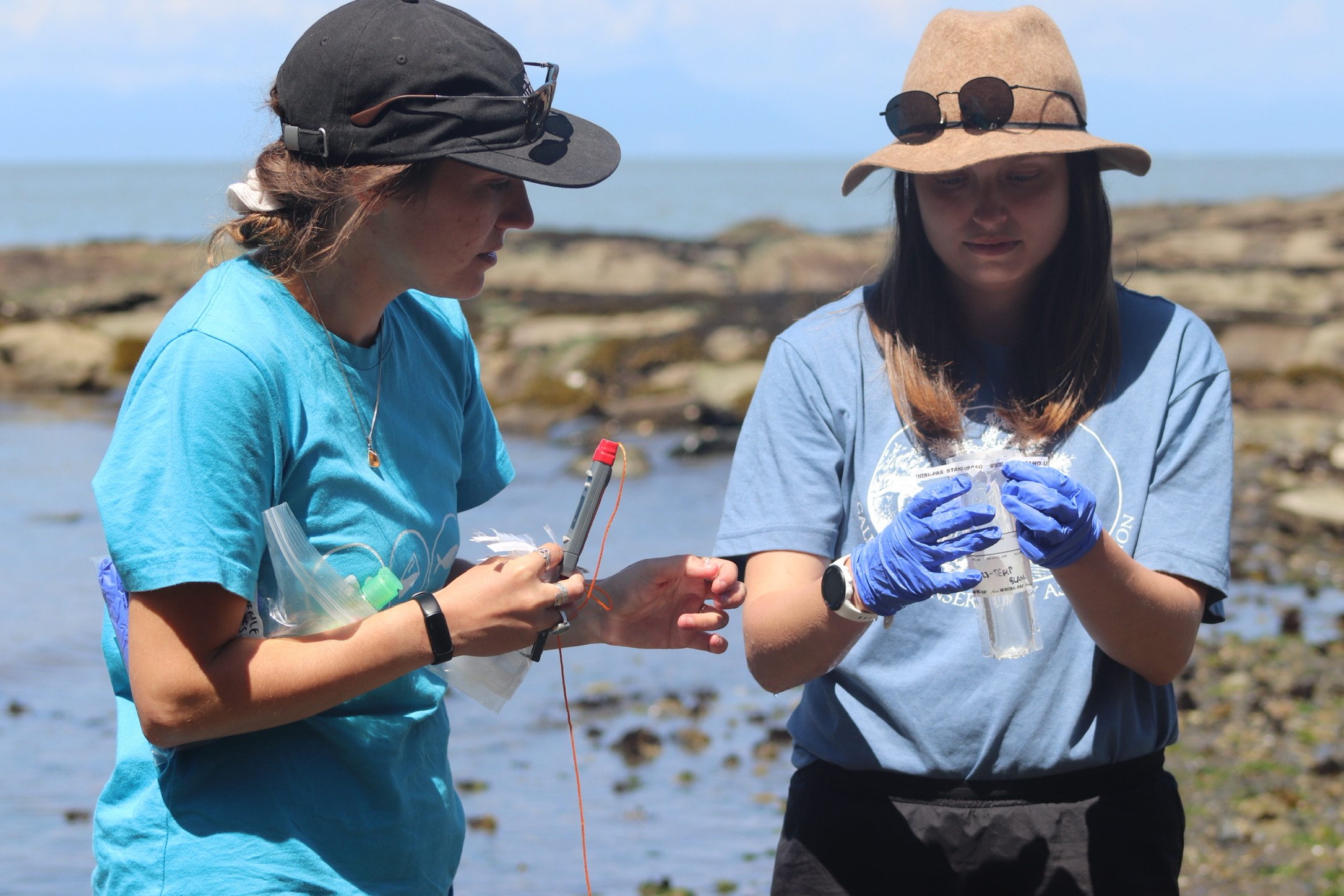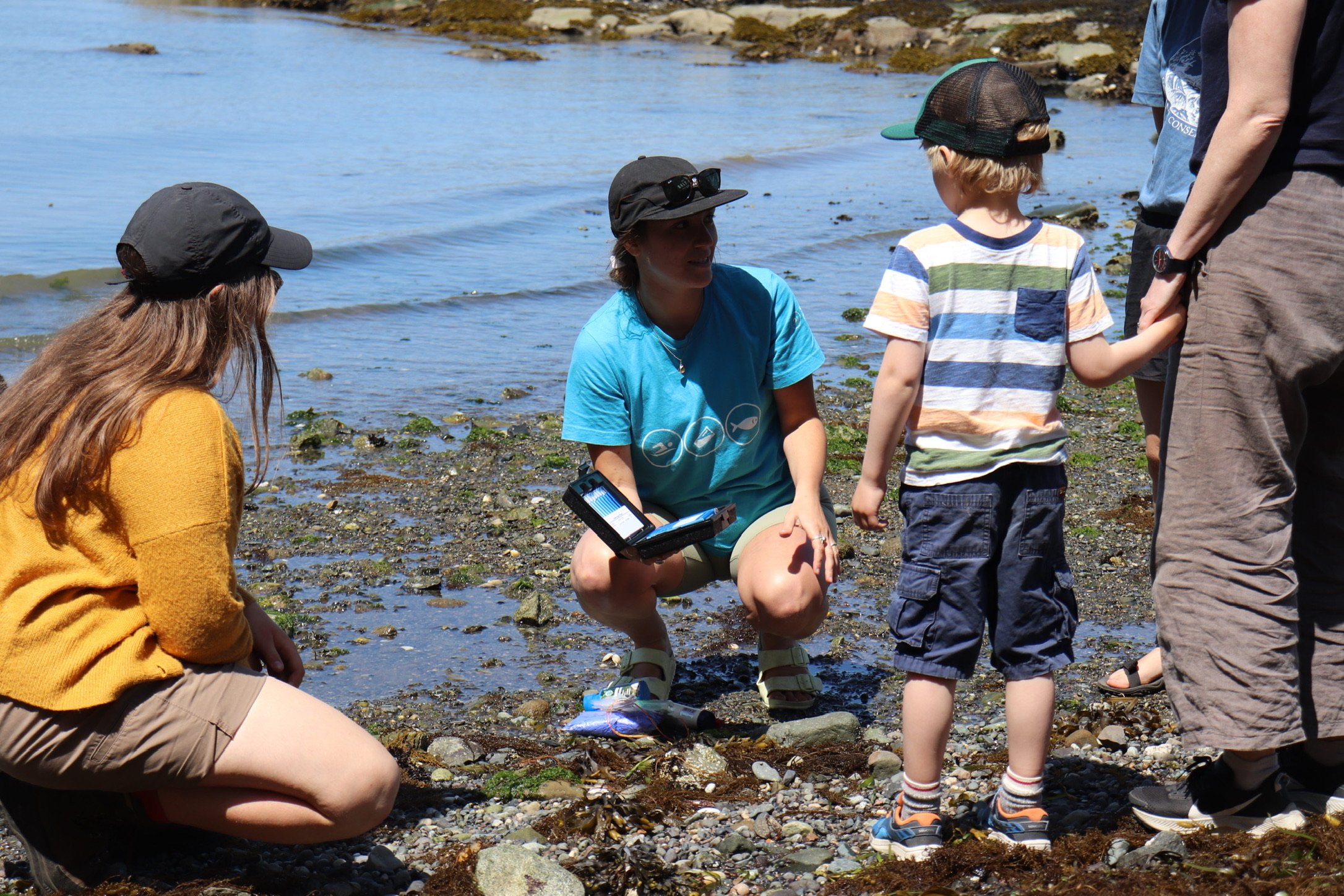Galiano Island BioBlitz
Our findings from the Galiano Island BioBlitz
Madeleine Ankenman and Michelle Thompson collect a sample from Pebble Beach on Galiano Island. Photo: Megan Robinson
This past weekend, Swim Drink Fish was fortunate enough to be part of the Galiano Island BioBlitz with the Galiano Conservancy Association, Oceanwise, Hakai Institute, Institute for Multidisciplinary Ecological Research in the Salish Sea (IMERSS) and a whole host of community members and visitors.
The goal of our visit was to investigate what impact the Fraser River might have on the water quality as far away as Galiano Island (roughly 40km). Locals prefer to swim on the East side of the island due to higher water temperatures created by the river outflow- an indication that the Fraser River is impacting the local waters. With this in mind, Swim Drink Fish sought to investigate whether the river is impacting water quality around the island, as well as temperature. The Fraser River has important water quality concerns, including the combined sewer and wastewater systems that flow into the river at a number of sites (for more information see Metro Vancouver’s CSO map), and agricultural run-off. Both of these pollution sources can increase harmful bacteria in the water such as total coliforms and E.coli, as well as, fertilizers from agriculture can increase harmful algal blooms.
As our monitoring hubs often discover though, it’s more than just water quality results we uncover, it’s a passionate community of nature lovers, dedicated to protecting the water, forests and wildlife sustaining our ecosystem.
Mirjam Weber, Cowan Patterson and Romney McPhie join Madeleine Ankenman for some community science Photo: Megan Robinson
This was evident from the moment we arrived on Galiano Island, where the shoreline was bustling with locals, visitors and bioblitzers in action documenting all that the Gulf Islands biodiversity has to offer, and participating in a full schedule of community science.
First, we learned about the Send a Sighting Save a Whale campaign from Education and Outreach Lead, Aaron Purdy at Oceanwise. Galiano Island is one of the BC’s best places to see whales like Orcas and Humpbacks swim through the Salish Sea.
The weekend also included a presentation from Hakai Institute’s Sentinels of Change, who allowed us to get up close and personal with their Light Traps initiative focused on the life journey of Dungeness Crab in the Salish Sea.
Community science did not stop there though. IMERSS was around all weekend to chat about their many ongoing community research projects, such as the Diatoms of the Salish Sea, where they’re studying a major group of photosynthetic micro-algae living in marine and freshwater environments, which provide vast quantities of oxygen, food and nutrients for a wide range of organisms.
As for ourselves, we put the community to work as well– monitoring the water quality of two different locations on Galiano Island. We first collected samples on the west side of the island on the Galiano Conservancy grounds (Crystal Cove), then on the east side of the island in Cable Bay (Pebble Beach).
Our Vancouver Water Programs Coordinator, Madeleine Ankenman was joined by a host of new Swim Drink Fish community scientists, who helped collect water samples, environmental observations and the rest of monitoring tasks to better understand the health of the water.
Results
It’s clear that total coliforms were the biggest finding from the weekend’s results. Although there is no health risk associated with total coliforms, they are indicative of biological pathogens entering the system from soils or sewer contamination. Meaning pollution.
Learn more about total coliforms here.
Other findings
The healthy range for pH levels for fish is 6.5-to-9, with the standard ocean level being 8, which means we are seeing slightly lower pH levels on the east side at Pebble Beach, compared to the results at Crystal Cove because of the freshwater influence from the Fraser River. E.Coli levels were well below (a good thing) British Columbia health standards which call for a 200mpn over 100mL geomean. Healthy Dissolved Oxygen levels are considered anything above 6.5-8 mg/L, but not all small fish can survive in waters with levels below 9.5mg/L.
Conclusion
Standing on the shores of Galiano Island is like nothing else. Bald eagles soar above, otters grace the coves and whales pass by with all their magic. There’s no question that Galiano Island’s biodiversity is in a class of its own. Though, like many places of Galiano’s beauty, sometimes there’s more needed to protect these pristine and unique places.
This weekend simply gave us preliminary and exploratory findings, but what it also gave us was the unequivocal understanding that the community, conservation association and all its partners are leading the charge in making sure we protect the places we love.
“The Bluffs” looking over Mayne Island at the Salish Sea. Photo: Megan Robinson
Thank you
The Community scientists that helped monitor the water quality for the weekend were Michelle Thompson, Aaron Purdy, Mirjam Weber, Becca Gray, Cowan Patterson and Romney McPhie. A big thank you goes out to Andrew Simon, IMERSS, Hakai Institute, Oceanwise and Galiano Conservancy Association for having us, and most of all, for the work they continue to do.
Please contact Matt Brown and Madeleine Ankenman with any questions and comments.
matt@swimdrinkfish.ca and madeleine@swimdrinkfish.ca





